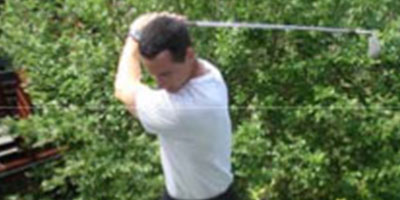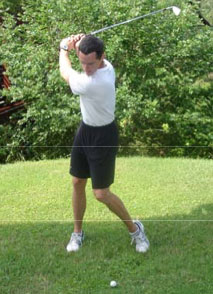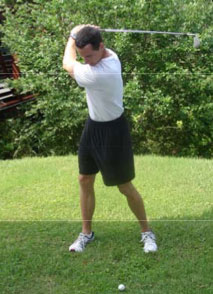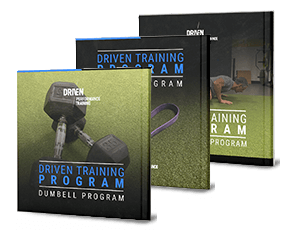“Relative Rotation” and the Golf Swing: Loading the Kinetic Chain

One of the most important concepts for golfers interested in improving the performance to understand is that of relative rotation. This term describes when one body segment rotates more than another body segment that is rotating the same way. When this occurs, the relative rotation causes a stretch to be placed on the muscle and connective tissue around those segments, allowing them to store potential energy. The situation is analogous to that of a rubber band around two fingers. If both fingers are moved right the same amount, the band doesn’t get stretched and does not store potential energy. If, however, the right finger moves farther right than the left, separation is created, and the band stretches and stores potential energy. During the golf swing, we have a glut of rubber bands (muscles, connective tissue) getting stretched. An outline of the key “bands” is below.
Loading the body during takeaway.
- Shoulders rotate to the right relative to the hips and head. The separation of the shoulders from the hips creates a stretch (load) through the abdominal muscles.
- The hips rotate to the right relative to right thigh, which moves only slightly. This loads the gluteal and hip external rotators on the right side.
- The right and left tibia rotate slightly to the right with the foot remaining firmly in contact with the ground. This loads the muscles of the calf and foot.
The net effect of allowing the shoulders to turn past the hips and the hips to turn past the legs with minimal rotation of the legs is a stretch of the hip and trunk musculature, storing an enormous amount of potential energy.
As you can see, loading the kinetic chain during the golf swing requires two key abilities:
- The mobility to create rotational separation between the segments listed above.
- The stability to maintain the position of one segment while the segment above it moves.
Properly loading the kinetic chain allows a golfer to store potential energy and convert it into kinetic energy in an effortless manner. However, there are many potential barriers to effective loading that impact the swing. The following two examples illustrate how physical restrictions can impact loading in the backswing.
Player 1.

Swing issues/body compromises: Inability to rotate the shoulders relative to the hips and hips relative to the legs causes the right knee to extend and the left heel to lift off the ground. This unloads the abdominals and gluteal muscles, robbing the body of the ability to store potential energy. Consequently, the player becomes overreliant on his shoulders and arms to initiate the swing and create clubhead speed. The elbows and shoulders take the brunt of the abuse.
Player 2.

Swing issues: Player 2 overrotates. The shoulder turn pulls the hips along, with minimal separation created. The hips rotate, straightening the right knee and causing the right leg to rotate outward. At the top of the swing the arms bend at the elbow, allowing the club to drop down to the level of the shoulders. This creates an extremely long swing. However, this player’s rotational instability causes little energy to be stored, causing him to lengthen his swing in a last ditch attempt to create more speed. So many uncontrolled parts make for a swing that is not very powerful or repeatable.
When you analyze the complexity of the golf swing, there is a superfluity of opportunities for tightness or instability to cause compensation. 10 different people will likely have at least that many different limiting factors that impact their swings. Therefore, there are not one or two simple exercises that can be universally applied to golfers. Instead, take a more comprehensive approach, identifying where your body lacks mobility and stability. Armed with the knowledge that comes from a thorough evaluation, you, your swing coach and trainer can begin to address the physical restrictions that affect your swing.
SHARE IT


